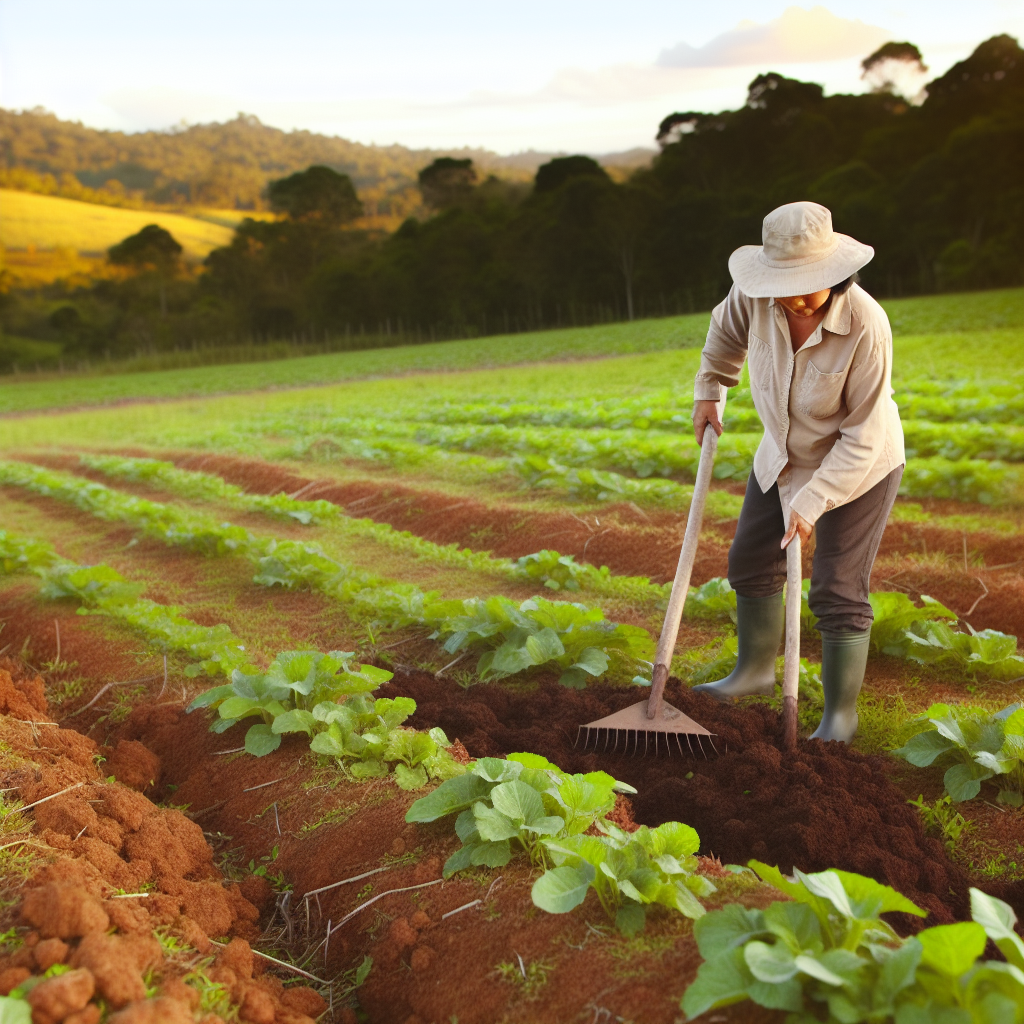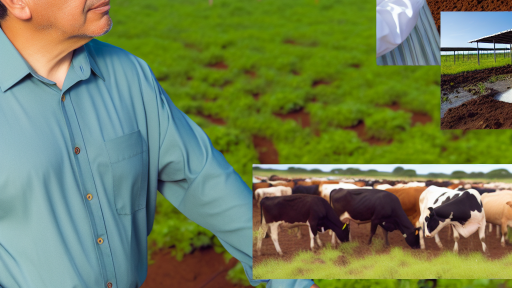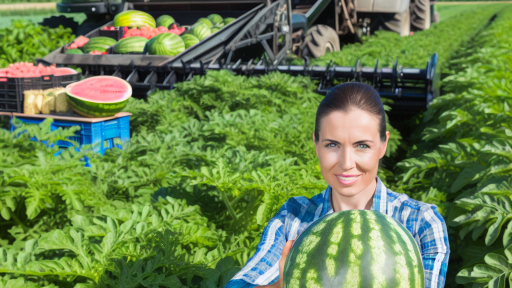Introduction to Soil Health
Soil health is vital for small-scale farmers.
Healthy soils support productive crops.
In addition, they enhance resilience to climate change.
Understanding soil health can lead to better farming practices.
Importance of Soil Health
Good soil health impacts crop yields significantly.
It increases nutrient availability for plants.
Moreover, healthy soil improves water retention.
This reduction in water loss promotes sustainable practices.
Economic Benefits
Investing in soil health can save money over time.
Farmers can reduce fertilizer and pesticide use.
In turn, this leads to cost savings and healthier profits.
Environmental Impact
Healthy soils trap carbon effectively.
This helps mitigate climate change effects.
Additionally, they protect local water quality.
Moreover, healthy soils support diverse ecosystems.
Transform Your Agribusiness
Unlock your farm's potential with expert advice tailored to your needs. Get actionable steps that drive real results.
Get StartedPractical Steps for Improvement
Small-scale farmers can adopt several practices.
They should consider cover cropping to enhance soil nutrients.
Practices like crop rotation can also be beneficial.
Furthermore, reduced tillage methods maintain soil structure.
Understanding Soil Composition: Key Components for Soil Health
Introduction to Soil Composition
Soiil composition plays a crucial role in agricultural productivity.
Farmers must understand the various components that influence soil health.
This understanding directly impacts crop yield and sustainability.
Mineral Content
Minerals are foundational to soil structure and fertility.
Soil contains essential nutrients like nitrogen, phosphorus, and potassium.
These nutrients promote healthy plant growth and development.
Farmers should regularly test soil to determine mineral levels.
This testing helps in making informed fertilization choices.
Organic Matter
Organic matter enriches soil and improves its structure.
It consists of decomposed plants, animals, and microbial activity.
Adding compost increases nutrient availability in the soil.
Moreover, organic matter enhances moisture retention.
Farmers can boost organic content by rotating crops and cover cropping.
Soil Texture
Soil texture is determined by the proportion of sand, silt, and clay.
It affects water retention, drainage, and root penetration.
Clay holds water well but may drain poorly.
Conversely, sandy soil drains quickly but may lack nutrients.
Farmers can amend soil texture to improve crop conditions.
Soil pH
Soil pH significantly influences nutrient availability.
It measures the acidity or alkalinity of the soil.
Showcase Your Farming Business
Publish your professional farming services profile on our blog for a one-time fee of $200 and reach a dedicated audience of farmers and agribusiness owners.
Publish Your ProfileMost crops thrive in slightly acidic soil with a pH of 6.0 to 7.0.
Applying lime can raise soil pH, while sulfur can lower it.
Regular pH testing should guide soil management practices.
Microbial Activity
Microbial life is essential for breaking down organic matter.
Bacteria, fungi, and other microorganisms enrich the soil ecosystem.
Healthy microbial activity improves nutrient cycling.
Farmers can support this by minimizing chemical fertilizers and pesticides.
Encouraging diverse planting can also enhance microbial diversity.
Implications of Understanding Soil Composition
Understanding these components helps small-scale farmers manage soil effectively.
Healthy soil leads to successful crop production and sustainability.
Farmers should prioritize soil health for long-term agricultural success.
Assessing Soil Health: Methods and Tools for Soil Testing
Importance of Soil Testing
Soil testing provides vital information about nutrient levels.
It helps farmers improve crop yields effectively.
Moreover, testing identifies soil health issues early.
This proactive approach allows for timely interventions.
Types of Soil Tests
Various soil tests evaluate different aspects of soil health.
A standard soil test measures pH, nutrient levels, and organic matter.
Similarly, a microbial test assesses the biological activity in soil.
Additionally, a texture test analyzes the soil’s composition.
Tools for Soil Testing
Farmers can use both DIY kits and professional services.
Home kits offer convenient sampling and analysis options.
Professional laboratories provide detailed and accurate results.
Many farmers choose laboratories for comprehensive testing.
Steps for Conducting Soil Tests
Start by selecting representative soil samples from your fields.
Ensure samples are collected at a consistent depth.
Then, mix the samples and prepare for analysis.
Finally, send samples to a lab or use your testing kit.
Interpreting Soil Test Results
Understand the key parameters in your test results.
Focus on pH levels, nutrient availability, and organic matter content.
Consider how these factors affect your specific crops.
Consult local agricultural extension services for guidance.
Implementing Soil Management Practices
Use soil test results to develop effective management strategies.
Rotate crops to enhance soil fertility and health.
Add organic amendments like compost or green manure.
Additionally, apply fertilizers based on test recommendations.
Delve into the Subject: Promoting Ethical Farming In Communities
Soil Fertility Management: Organic vs. Chemical Fertilizers
Understanding Soil Fertility
Soil fertility is crucial for healthy crops.
It includes the ability of soil to provide essential nutrients.
Farmers must assess their soil’s fertility regularly.
Organic Fertilizers
Organic fertilizers come from natural sources.
Showcase Your Farming Business
Publish your professional farming services profile on our blog for a one-time fee of $200 and reach a dedicated audience of farmers and agribusiness owners.
Publish Your ProfileThey include compost, manure, and plant residues.
These fertilizers improve soil structure and health.
Additionally, they promote biodiversity in the soil.
Using organic fertilizers enhances nutrient retention.
Consequently, crops benefit from improved nutrient availability.
Benefits of Organic Fertilizers
- Enhance soil organic matter.
- Reduce the risk of nutrient leaching.
- Support beneficial microorganisms.
- Improve water retention in soils.
Chemical Fertilizers
Chemical fertilizers are synthetic products.
They provide nutrients in concentrated forms.
These fertilizers offer quick nutrient availability to plants.
Farmers often use them to boost short-term crop yields.
However, excessive use can harm soil health.
Drawbacks of Chemical Fertilizers
- Can lead to soil degradation over time.
- May pollute water sources.
- Can disrupt soil microbial communities.
- Potentially create nutrient imbalances.
Making the Right Choice
Farmers must evaluate their specific needs.
Consider factors like soil type, crop demands, and budget.
Using a combination of both fertilizers may work best.
Ultimately, aim for sustainable practices in soil management.
Gain More Insights: Sustainable Soil Management Practices
Crop Rotation and Diversity: Techniques to Enhance Soil Health
Importance of Crop Rotation
Crop rotation plays a vital role in maintaining soil health.
This practice involves alternating crops in specific sequences over time.
Doing so enhances soil structure and fertility.
Moreover, it helps disrupt pest and disease cycles.
Variety in crop types boosts the diversity of the soil microbiome.
Implementing Effective Crop Rotation
Start by selecting diverse crops suited to your local climate.
For instance, legumes can fix nitrogen in the soil.
Next, plant deep-rooted crops to improve soil structure.
Additionally, consider seasonal crops to maximize growth throughout the year.
Always monitor soil health regularly, adjusting your rotation as needed.
Benefits of Diverse Planting
Diversity benefits not only soil health but also ecosystem functions.
Planting multiple species decreases the risk of crop failure.
It also attracts beneficial insects and pollinators.
Consequently, this promotes natural pest control methods.
Integrating Cover Crops
Cover crops provide excellent soil protection during off-seasons.
They prevent soil erosion and nutrient leaching.
Additionally, cover crops enhance organic matter content.
- Common choices include clover, rye, and vetch.
- Each of these contributes uniquely to soil quality.
Using Organic Amendments
Incorporating organic amendments supports sustainable soil health management.
Options include compost, manure, and green leaf mulch.
These materials improve nutrient availability and microbial activity.
Furthermore, they enhance moisture retention in the soil.
Regular application promotes a thriving soil ecosystem.
Monitoring Soil Health
Regularly assess your soil health for optimal results.
Gather samples and test for pH, nutrient levels, and organic matter.
Based on results, adjust your rotations and amendments accordingly.
Showcase Your Farming Business
Publish your professional farming services profile on our blog for a one-time fee of $200 and reach a dedicated audience of farmers and agribusiness owners.
Publish Your ProfileKeeping records helps track changes over time.
This practice enables you to make informed management decisions.
Gain More Insights: Starting Your Own Community Supported Agriculture
Cover Cropping: Benefits and Implementation for Small Farms
Benefits of Cover Cropping
Cover cropping enhances soil health significantly.
It reduces erosion by shielding the soil from wind and rain.
Additionally, cover crops improve water retention in the soil.
They also suppress weeds, reducing the need for herbicides.
Furthermore, they can enhance soil nitrogen levels through nitrogen-fixing species.
This practice promotes biodiversity in crop rotations.
Ultimately, it can lead to higher yields and better crop quality.
Types of Cover Crops
Choosing the right cover crop is essential for effectiveness.
Cereal rye is an excellent winter cover crop.
It grows quickly and establishes well.
Legumes, like clover, fix nitrogen in the soil.
Brassicas, such as radishes, break compacted soil layers.
Selecting a mix of cover crops can optimize benefits.
Implementation Strategies
Planning is crucial before planting cover crops.
Assess your specific soil needs and crop goals.
Timing of planting and termination plays a significant role.
Plant cover crops after harvest and terminate before main crops.
Consider using no-till methods to preserve soil structure.
Monitor crop growth and adjust management practices as needed.
Challenges and Solutions
Small-scale farmers may face challenges with cover cropping.
Costs associated with seeds and equipment can be a barrier.
Additionally, managing cover crops requires time and knowledge.
Seeking local agricultural extension services can provide support.
Joining farmer cooperatives can help share resources and knowledge.
Ultimately, the benefits often outweigh the initial challenges.
Delve into the Subject: Creating a Subscription Box for Farm Products

Soil Erosion Control: Strategies to Protect Soil Integrity
Understanding Soil Erosion
Soil erosion threatens farm sustainability.
It occurs when wind or water removes topsoil.
This loss reduces soil fertility significantly.
Adopting Conservation Tillage
Conservation tillage minimizes soil disturbance.
This practice preserves soil structure and moisture.
Additionally, it increases organic matter over time.
Implementing Cover Crops
Cover crops protect soil between growing seasons.
They prevent erosion by anchoring the soil.
Moreover, they enhance soil health and biodiversity.
Establishing Contour Farming
Contour farming follows the land’s natural contours.
This method slows water runoff effectively.
Showcase Your Farming Business
Publish your professional farming services profile on our blog for a one-time fee of $200 and reach a dedicated audience of farmers and agribusiness owners.
Publish Your ProfileConsequently, it reduces soil erosion on slopes.
Using Buffer Strips
Buffer strips are vegetative areas next to water bodies.
They filter pollutants before reaching waterways.
Moreover, they slow down surface runoff, protecting soil.
Practicing Crop Rotation
Crop rotation diversifies crops in a specific area.
This technique breaks pest cycles effectively.
Furthermore, it improves soil structure and nutrient levels.
Encouraging Organic Matter Addition
Adding organic matter enhances soil’s moisture retention.
It also boosts microbial activity and fertility.
Composting and mulching boost organic matter effectively.
Engaging Community Programs
Joining local agricultural programs offers support.
Many organizations provide resources for best practices.
Community knowledge-sharing enhances soil management efforts.
Water Management: Impact on Soil Health and Crop Yield
Importance of Water Management
Effective water management is crucial for soil health and crop yield.
It helps maintain soil structure and nutrient availability.
Furthermore, appropriate water management prevents erosion and loss of soil fertility.
Strategies for Efficient Water Management
Farmers can implement several strategies to manage water effectively.
- Utilize drip irrigation to minimize water waste.
- Employ rainwater harvesting systems for irrigation.
- Implement mulching to reduce evaporation from the soil.
These methods enhance water use efficiency in crops.
Impact of Water on Soil Health
Water plays a vital role in soil microbial activity.
Healthy soil microorganisms improve nutrient cycling.
Moreover, balanced water levels promote root growth in plants.
This results in increased crop resilience against pests and diseases.
Consequences of Poor Water Management
Poor water management can lead to several negative outcomes.
- Excessive watering may cause soil salinization.
- Insufficient watering can stress plants and reduce yield.
- Poor drainage can lead to waterlogging and root rot.
Farmers should monitor their practices to avoid these issues.
Balancing Water Usage and Soil Conservation
Balancing water usage with soil conservation is essential for sustainability.
Farmers should regularly assess soil moisture levels.
Additionally, they can adopt contour plowing to manage water runoff.
This practice helps maintain soil integrity while managing water effectively.
Building a Soil Management Plan
Assessing Current Soil Conditions
Start by evaluating your existing soil health.
Take soil samples from multiple locations on your farm.
Send the samples to a reputable lab for testing.
Examine results to identify nutrient deficiencies and pH levels.
Setting Goals for Soil Health
Establish clear objectives for improving soil quality.
Consider crop yields, biodiversity, and water retention.
Align your goals with sustainable farming practices.
Incorporating Organic Matter
Add organic matter to enhance soil structure and fertility.
Utilize compost, cover crops, and green manures as sources.
Rotate cover crops to maximize benefits and prevent disease.
Implementing Conservation Practices
Adopt conservation practices to prevent soil erosion.
Consider no-till or reduced-till methods for your fields.
Showcase Your Farming Business
Publish your professional farming services profile on our blog for a one-time fee of $200 and reach a dedicated audience of farmers and agribusiness owners.
Publish Your ProfilePlant grass strips along waterways to stabilize soil.
Monitoring Progress Regularly
Keep track of changes to soil health over time.
Use follow-up soil tests to measure improvements.
Adjust your management practices based on monitoring results.
Engaging with the Community
Connect with other farmers and local agricultural experts.
Join workshops or seminars focused on soil management.
Exchange experiences and strategies for success.
Staying Informed about Best Practices
Continuously educate yourself on soil health advancements.
Subscribe to agricultural magazines or online resources.
Attend local agricultural fairs and community events for insights.
Additional Resources
Partnerships for Climate-Smart Commodities Project Summaries …




